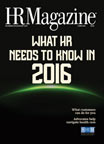
 In 2016, most CEOs will tell you that talent is their organization’s most precious asset and their culture is their best competitive advantage. Yet for many companies there remains a gaping hole between that rhetoric and reality.
In 2016, most CEOs will tell you that talent is their organization’s most precious asset and their culture is their best competitive advantage. Yet for many companies there remains a gaping hole between that rhetoric and reality.
This presents a tremendous leadership opportunity for HR, the one team that touches all parts of an organization. HR professionals are in a prime position to assess what our most productive and engaged teams are doing—and to build a culture around them. Here are four ways to do that in 2016:
Serve the organization by serving the team leader. Engagement is driven by team leaders. Yet in most organizations, HR measures engagement in an annual survey, with team leaders getting their data months later. HR professionals must put the right tools in the right hands, which means developing strong relationships with team leaders.
Engage in dynamic teaming. Teaming today is shifting rapidly as new employment models emerge and more workers think of jobs as short-term gigs rather than lifelong journeys. Our tools should reflect this reality, rather than being deployed through static, hierarchical boxes on an org chart.
If we don’t have the agility to keep up with dynamic teams in real time, we’re acting on data that’s out-of-date or irrelevant.
Gather real-time, reliable metrics. Most engagement surveys ask a long series of questions that show no correlation to retention or improved performance.
To address this disconnect, we must identify the questions that drive the outcomes we want and put the data back in the hands of team leaders to deploy right now. Mission Health and Hampton Hotels are great examples of companies getting this right.
In addition, as many organizations are discovering, performance assessment is in need of an overhaul. General Electric, Accenture and Deloitte joined a growing number of companies this year in abandoning traditional annual reviews. While there’s certainly a need for innovation, doing away with ratings altogether is not viable. Organizations will always need a way to differentiate talent.
Yet we know that rating people based on goals produces bad data. In fact, 61 percent of a performance assessment reflects the person assigning the rating rather than the one being evaluated.
Fortunately, we can accurately assess people’s own intentions. To gather good performance data, regularly ask team leaders a few questions about their plans for every team member: Who deserves a promotion? Who needs more training? By aggregating the data, the organization will see, quarter by quarter, what to do with each person.
Employ machine-learning algorithms. Once we have the right methods in place, our systems should be smart enough to learn, over time, the rating patterns of each individual. That will help neutralize people’s inescapable biases.
We can even apply algorithms to measure individuals’ strengths, thereby ensuring that all training and coaching fit each person’s particular style and talents. Facebook has adopted an approach like this and infused it through the company at the team leader level.
To build high-functioning organizations, we must identify the best teams and build more just like them. If HR professionals can do that, they will lead their organizations to greatness in 2016.
Marcus Buckingham is founder of engagement and performance solution company TMBC, a best-selling author and a leadership thought leader.
Advertisement
An organization run by AI is not a futuristic concept. Such technology is already a part of many workplaces and will continue to shape the labor market and HR. Here's how employers and employees can successfully manage generative AI and other AI-powered systems.
Advertisement


